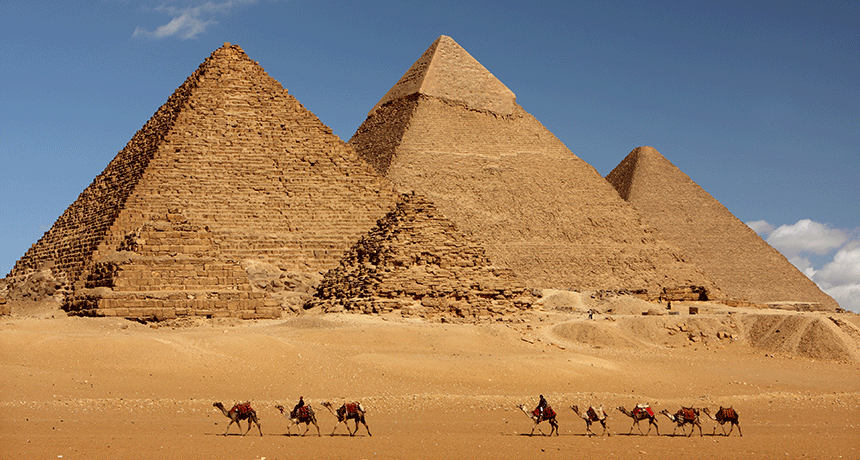
The Great Pyramid of Giza (otherwise called the Pyramid of Khufu or the Pyramid of Cheops) is the most established and biggest of the three pyramids in the Giza pyramid complex circumscribing what is currently El Giza, Egypt. It is the most established of the Seven Wonders of the Ancient World, and the just a single to remain to a great extent in place.
In light of a stamp in an inside load naming the work posse and a reference to fourth line Egyptian Pharaoh Khufu, Egyptologists trust that the pyramid was worked as a tomb over a 10 to 20-year time frame closing around 2560 BC. At first at 146.5 meters (481 feet), the Great Pyramid was the tallest man-made structure on the planet for over 3,800 years. Initially, the Great Pyramid was secured by packaging stones that shaped a smooth external surface; what is seen today is the basic center structure. A portion of the packaging stones that once secured the structure can in any case be seen around the base. There have been shifting logical and elective speculations about the Great Pyramid's development procedures. Most acknowledged development theories depend on the possibility that it was worked by moving gigantic stones from a quarry and dragging and lifting them into put.
There are three known chambers inside the Great Pyramid. The most minimal chamber is cut into the bedrock whereupon the pyramid was assembled and was incomplete. The so-called[1] Queen's Chamber and King's Chamber are higher up inside the pyramid structure. The fundamental piece of the Giza complex is a setting of structures that included two funeral home sanctuaries out of appreciation for Khufu (one near the pyramid and one close to the Nile), three littler pyramids for Khufu's spouses, a much littler "satellite" pyramid, a raised boulevard associating the two sanctuaries, and little mastaba tombs encompassing the pyramid for nobles.
Egyptologists trust the pyramid was worked as a tomb for the Fourth Dynasty Egyptian pharaoh Khufu (frequently Hellenicised as "Cheops") and was developed over a 20-year time span. Khufu's vizier, Hemiunu (additionally called Hemon), is accepted by some to be the designer of the Great Pyramid.[2] It is imagined that, at development, the Great Pyramid was initially 280 Egyptian Royal cubits tall (146.5 meters (480.6 ft)), yet with disintegration and nonappearance of its pyramidion, its present tallness is 138.8 meters (455.4 ft). Each base side was 440 cubits, 230.4 meters (755.9 ft) long. The mass of the pyramid is evaluated at 5.9 million tons. The volume, including an inside hillock, is approximately 2,500,000 cubic meters (88,000,000 cu ft).[3]
In view of these appraisals, fabricating the pyramid in 20 years would include introducing roughly 800 tons of stone each day. Also, since it comprises of an expected 2.3 million squares, finishing the working in 20 years would include moving a normal of more than 12 of the pieces into put every hour, day and night. The main exactness estimations of the pyramid were made by Egyptologist Sir Flinders Petrie in 1880– 82 and distributed as The Pyramids and Temples of Gizeh.[4] Almost all reports depend on his estimations. A considerable lot of the packaging stones and internal chamber squares of the Great Pyramid fit together with to a great degree high accuracy. In view of estimations gone up against the northeastern packaging stones, the mean opening of the joints is just 0.5 millimeter wide (1/50 of an inch).[5]
Extraordinary Pyramid of Giza from a nineteenth century stereopticon card photograph
History and Description
The pyramid remained the tallest man-made structure on the planet for more than 3,800 years,[6] superb until the 160-meter-tall (520 ft) tower of Lincoln Cathedral was finished c. 1300. The exactness of the pyramid's workmanship is to such an extent that the four sides of the base have a normal blunder of just 58 millimeters in length.[7] The base is even and level to inside ±15 mm (0.6 in).[8] The sides of the square base are firmly adjusted to the four cardinal compass focuses (inside four minutes of arc)[9] in view of genuine north, not attractive north,[10] and the completed base was squared to a mean corner mistake of just 12 seconds of arc.[11]
The finished plan measurements, as recommended by Petrie's study and consequent investigations, are evaluated to have initially been 280 Egyptian Royal cubits high by 440 cubits in length at every one of the four sides of its base. The proportion of the edge to stature of 1760/280 Egyptian Royal cubits compares to 2π to a precision of superior to anything 0.05% (relating to the outstanding guess of π as 22/7). A few Egyptologists consider this to have been the aftereffect of think configuration extent. Verner expressed, "We can presume that despite the fact that the old Egyptians couldn't exactly characterize the estimation of π, by and by they utilized it".[12] Petrie, creator of Pyramids and Temples of Gizeh finished up: "however these relations of zones and of round proportion are systematic to the point that we should give that they were in the developer's design".[13] Others have contended that the Ancient Egyptians had no understanding of pi and would not have thought to encode it in their landmarks. They trust that the watched pyramid incline might be founded on a straightforward seked slant decision alone, with no respect to the general size and extents of the completed building.[14] In 2013, moves of papyrus called the Diary of Merer were found composed by some of the individuals who conveyed limestone and other development materials from Tora to Giza.[15]
Read More: https://goo.gl/Qt6Hnn